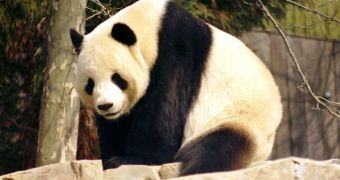Chinese scientists announce that they have finally completed the laborious task of mapping out all the 2.4 billion bases in the genetic code of the giant panda bear. The group plans to use the newfound knowledge to understand several traits that the animal has, including its preference for its current diet. The scientists also say that the work could lead to the development of more suited conservation programs that could see the endangered species returning to higher numbers over the coming years.
Jingjing, a three-year-old female panda, was the animal whose DNA was thoroughly investigated by the team. Although it was led by experts in China, the group included scientists from many countries around the globe. A detailed report of the findings was published online ahead of print, in the December 13 issue of the respected scientific journal Nature. “I was really thrilled to read this,” Donald Lindburg shares. The conservation scientist is the former head of the Zoological Society of San Diego's Office of Giant Panda Conservation, Wired reports.
In spite of the fact that the panda genome features about 600 million fewer base pairs than the humans' three-billion-base-pair genetic material, both species have about as many genes – 21,000 – encoded in their DNA. What really surprised the team was the fact that the experts couldn't find any signs of inbreedings. In fact, they discovered a high rate of heterozygosity, which is to say that the DNA samples from the pandas had many differences between them. Inbreeding was one of the main reasons considered by the international scientific community for the decline in panda populations.
Some experts say that the findings should be taken with a grain of salt, in the sense that previous studies have demonstrated that the rate of genetic change from one panda generation to the other may be slower than in humans and other species – which basically means that the pandas evolve slower. According to University of Copenhagen expert Jun Wang, the new results are in tune with the knowledge that the bear is a “living fossil,” an animal that evolves incredibly slow over the years. Wang, who is also employed at the BGI-Shenzhen, in China, is a coauthor for the new Nature paper.
In their work, the investigators determined that the panda had all the genes required to process food inside the gut, but none of the ones associated with digesting bamboo, which is its main source of food. This could mean, the experts say, that the animal relies solely on microbial communities inside its intestines to extract the nutrients out of the bamboo. The study “underscores the concept that the panda – and similarly the human – genetic landscape is truly made up of their own organismal and microbial genomes,” National Human Genome Research Institute microbiome expert Julie Segre concludes.

 14 DAY TRIAL //
14 DAY TRIAL //